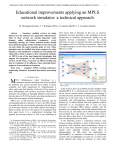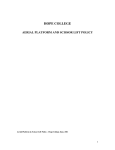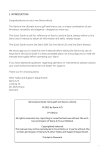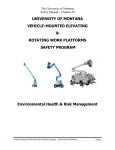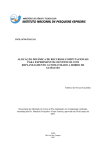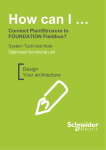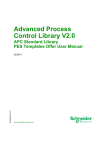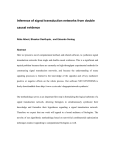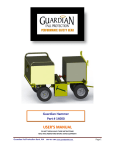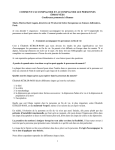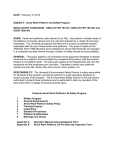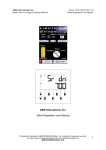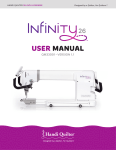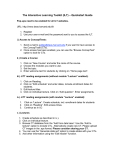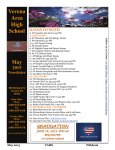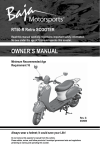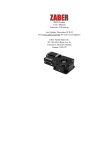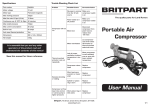Download Marathon Petroleum Company LP Aerial Work Platforms Document
Transcript
Marathon Petroleum Company LP Aerial Work Platforms 1.0 Page 1 of 12 PURPOSE 1.1 2.0 Document No.: RSW-SAF-011-DT Approval Date: 01/08/15 Revision No.: 2 Next Revision Date: 01/08/20 Document Custodian: Environmental, Safety and Security This practice provides the basis for the safe operation of aerial work platforms. SCOPE 2.1 This procedure applies to all persons working for Michigan Refining Division or on MRD property, including contractors and visitors. 2.2 This procedure applies to equipment that has a primary function of elevating personnel, together with their tools and necessary materials, on a platform, which is mechanically positioned. 3.0 GUIDELINE 3.1 Requirements for Operating Aerial Lifts 3.1.1 Operation of aerial lift equipment may only be performed by a trained employee. 3.1.1.1 An operator’s permit must be carried by those operating an aerial work platform or be available at the job site and must be displayed upon request. 3.1.1.2 The permit must indicate the type or model of aerial work platforms an operator has been trained on and is qualified to operate. 3.1.1.3 Permits must include at a minimum information regarding: 3.1.1.3.1 Date the permit was issued 3.1.1.3.2 The specific type of equipment the employee is approved to use. 3.1.1.3.3 The name of the person authorizing the permit. ATTENTION: Printed copies should be used with caution. The user of this document must ensure the current approved version of the document is being used. This copy was printed on 1/8/2015 2:36:00 PM Aerial Work Platforms Doc. No.: RSW-SAF-011--DT 3.1.1.3.4 Rev. No.: 2 Page 2 of 12 The expiration date of the permit. 3.1.1.4 A permit to operate an aerial work platform is valid only when performing work for the employer who issued the permit. 3.1.1.5 A permit shall be issued for a period of not more than 3 years. 3.1.2 The aerial work platform must be used and maintained in accordance with manufacturers operating instructions. 3.1.3 Aerial work platform operation instructions/ user manual must be kept with the aerial work platform at all times. 3.2 Requirements for Aerial Lift Equipment 3.2.1 An aerial work platform must bear a permanent plate stating the designated rating capacity. 3.2.2 The lifting and outrigger (if applicable) systems of an aerial work platform must be equipped with the means, such as but not limited to, a pilot operated check valve to ensure that the system will not permit the work platform to drop in a free fall in event of a power failure or hydraulic line failure. 3.2.3 Aerial work platforms must be equipped with emergency controls at ground level. 3.2.3.1 Emergency ground level controls must be clearly marked as to their intended function and be capable of overriding the platform controls. 3.2.4 Manufacturers operating instructions and safety rules must be available and legible on each unit. 3.3 3.2.5 Aerial work platforms are not to be used as insulated aerial devices. 3.2.6 Field modification of aerial work platforms is prohibited. Training ATTENTION: Printed copies should be used with caution. The user of this document must ensure the current approved version of the document is being used. This copy was printed on 1/8/2015 2:36:00 PM Aerial Work Platforms Doc. No.: RSW-SAF-011--DT 3.3.1 Rev. No.: 2 Page 3 of 12 Employees may operate an aerial device only after being trained in the operations, hazards, safeguards and safe practices of this procedure and receiving an Operators Permit for each specific type of aerial work platform they will operate. 3.3.1.1 Training must meet the requirements set by MIOSHA for Aerial Work Platforms. 3.3.1.2 At a minimum training must cover information on all decals, warnings and instructions displayed on the aerial work platform, the intended purpose and function of each of the controls and the rules and regulations set forward by MIOSHA for Safe Use of an Aerial Work Platform. 3.4 Safe Use of Aerial Lifts 3.4.1 Altering, modifying or disabling safety devices or interlocks is prohibited. 3.4.2 Stunt driving and horseplay are prohibited. 3.4.3 Only employees, their tools and necessary materials may be on or in the platform. 3.4.4 Employees must maintain firm footing on the platform while working on the platform. 3.4.5 Aerial work platforms must be elevated only when on a firm and level surface or within the slope limits allowed as stated by the manufacturer’s instructions. 3.4.6 The aerial work platform must not be positioned against another object to steady the platform. 3.4.7 Outriggers or stabilizers must be used when available. 3.4.7.1 Outriggers and stabilizers must be positioned on pads or on a solid surface. ATTENTION: Printed copies should be used with caution. The user of this document must ensure the current approved version of the document is being used. This copy was printed on 1/8/2015 2:36:00 PM Aerial Work Platforms Doc. No.: RSW-SAF-011--DT 3.4.8 Rev. No.: 2 Page 4 of 12 The designed rated capacity for a given angle of elevation must not be exceeded. 3.4.9 The manufacturer's rated load capacity must not be exceeded. 3.4.9.1 The aerial lift user must ensure that the load and its distribution on the platform are in accordance with the manufacturer's specifications. 3.4.9.2 The combined weight of workers and tools must not to exceed the rated load capacity of the equipment set by the manufacturer. 3.4.10 A platform operator must ensure that the area surrounding the aerial work platform is clear of personnel and equipment before lowering the platform. 3.4.11 If the platform or elevating assembly becomes caught, snagged, or otherwise prevented from normal motion by adjacent structures or other obstacles so that control reversal does not free the platform, all employees must exit the platform before attempts are made to free the platform. 3.4.12 Consideration must be given when working near power lines. For information on working near power lines consult Rigging and Lifting RSW SAF-029 Section 3.3 Electrical Hazards. 3.4.13 Aerial work platforms must be moved to a safe location and have their baskets lowered to the ground for parking and stowing. 3.5 Fall Protection on Aerial Lifts 3.5.1 Fall protection and fall protection PPE must be provided and used on aerial lifts so as to remain in compliance with Fall Protection RSW SAF066. 3.5.2 100% tie off is required in all aerial lifts. ATTENTION: Printed copies should be used with caution. The user of this document must ensure the current approved version of the document is being used. This copy was printed on 1/8/2015 2:36:00 PM Aerial Work Platforms Doc. No.: RSW-SAF-011--DT 3.5.3 Rev. No.: 2 Page 5 of 12 The guardrail system of the platform must not be used to support any of the following: 3.5.3.1 Materials. 3.5.3.2 Other work platforms. 3.5.3.3 Employees. 3.5.4 Use of railings, planks, ladders or any other devices on the platform to reach additional heights is prohibited. 3.5.5 Platform gates must be closed while the platform is in an elevated position. 3.5.6 Employees must not belt off to any adjacent poles, structures, or other equipment while working from an aerial work platform. 3.5.7 Employees must not tie off to any part of an aerial lift other than the manufactured rated tie-off point provided on the aerial lift. 3.5.7.1 Check aerial lift owner manuals or operating manuals for location and instructions on manufacturer tie off points. 3.5.8 Employees are prohibited from exiting an elevated aerial work platform, except where elevated work areas are otherwise inaccessible or hazardous to reach. If necessary employees may only exit the platform when it is the safest and last practical alternative. 3.5.9 Exiting the platform must only be executed with the knowledge and approval of Detroit Refinery supervision and the safety department. 3.5.9.1 When employees exit to unguarded work areas, a fall protection plan must be in place and personal fall arrest must be used (100% tie-off) and acceptable anchor points must be available and used as required in Fall Protection RSW SAF-066. 3.6 Traveling with Aerial Lifts ATTENTION: Printed copies should be used with caution. The user of this document must ensure the current approved version of the document is being used. This copy was printed on 1/8/2015 2:36:00 PM Aerial Work Platforms Doc. No.: RSW-SAF-011--DT 3.6.1 Rev. No.: 2 Page 6 of 12 Only aerial platforms that are equipped with a manufacturers installed platform controls for horizontal movement may be moved while in the elevated position. 3.6.2 Before and during driving, while elevated an operator of a platform must do the following: 3.6.2.1 Look in the direction of and keep a clear view of the path of travel. 3.6.2.2 Maintain a safe distance from obstacles, over head obstructions, debris, drop-offs, holes, and other potential hazards. 3.6.2.3 If traveling in an area with tight access or limited visibility considerations must be made prior to use of the equipment to use a spotter. 3.6.3 The aerial work platform must not be operated from a position on a truck, trailer, and railway car, floating vessel, scaffold or similar equipment. 3.6.4 The boom and platform of the aerial work platform must not be used to move or jack the wheels off the ground unless the machine is designed for that purpose by the manufacturer. 3.6.5 A vehicle-mounted aerial work platform must have wheel chocks installed before using the unit on an incline. 3.6.6 3.7 Fall protection (100% tie-off) must be maintained during any travel. Equipment Inspection 3.7.1 Each aerial work platform must be inspected, maintained, repaired and kept in proper working condition in accordance with the manufacturer’s operating or maintenance and repair manual or manuals. 3.7.2 An operator must inspect an aerial work platform for defects that would affect its safe operation and use before it is used on each work shift. The visual inspection must consist of all of the following procedures: 3.7.2.1 Visual inspection for all of the following: ATTENTION: Printed copies should be used with caution. The user of this document must ensure the current approved version of the document is being used. This copy was printed on 1/8/2015 2:36:00 PM Aerial Work Platforms Doc. No.: RSW-SAF-011--DT Rev. No.: 2 3.7.2.1.1 Cracked welds. 3.7.2.1.2 Bent or broken structural members. 3.7.2.1.3 Hydraulic or fuel leaks. 3.7.2.1.4 Damaged controls and cables. 3.7.2.1.5 Loose wires. 3.7.2.1.6 Tire condition. 3.7.2.1.7 Fuel and hydraulic fluid levels. 3.7.2.1.8 Slippery conditions on the platform. 3.7.2.1.9 Operate all platform and ground controls to ensure Page 7 of 12 that they perform their intended function. 3.7.3 All unsafe items found as a result of the inspection of the aerial work platform must be corrected before further use of the aerial work platform. 3.7.4 Any aerial work platform found not to be in a safe operating condition shall be removed from service until repaired. 3.7.4.1 3.7.5 All repairs shall be made by an authorized person. Any aerial work platform removed from service must have its key turned into employee’s supervisor. 3.7.5.1 The aerial work platform must be tagged as out of service. 3.8 Work Area Inspection 3.8.1.1 Before the aerial work platform is used, and during use on the job site, the operator must inspect for all of the following: 3.8.1.1.1 Ditches. 3.8.1.1.2 Drop-offs. 3.8.1.1.3 Holes. 3.8.1.1.4 Bumps and floor obstructions. 3.8.1.1.5 Debris. 3.8.1.1.6 Overhead obstructions. 3.8.1.1.7 Power lines. ATTENTION: Printed copies should be used with caution. The user of this document must ensure the current approved version of the document is being used. This copy was printed on 1/8/2015 2:36:00 PM Aerial Work Platforms Doc. No.: RSW-SAF-011--DT 3.8.1.1.8 Rev. No.: 2 Page 8 of 12 The area around the aerial work platform must also be inspected to assure clearance for the platform and other parts of the unit. 3.8.1.2 Any overhead wire shall be considered to be an energized line until the owner of the line, his or her authorized representative, or a utility representative assures one of the following: 3.8.1.2.1 The line is de-energized and has been visibly grounded. 3.8.1.2.2 The line is insulated for the system voltages and the task will not compromise the insulation of the conductor and/or cause an electrical hazard. 3.8.1.2.3 For information on minimum clearance distances for energized lines please see SAF-029 Rigging and Lifting Section 3.3 Electrical Hazards. 3.8.1.3 Weather conditions must also be considered in the work area inspection. For additional information see General Safety Rules SAF-001. 3.8.1.3.1 In the event of wind conditions (gusts and/or sustained) of 25mph or greater, unless more restrictive by the specific manufacturer, aerial work platforms (e.g. JLGs/Genies/Scissor Lifts) will cease operations. 3.8.1.3.2 Restricted operations due to wind conditions must be adhered to until wind conditions have become less than 25 mph for duration of 15 minutes. 3.8.2 All unsafe items found as a result of the inspection of the work area must be corrected before further use of the aerial work platform 4.0 DEFINITIONS – ATTENTION: Printed copies should be used with caution. The user of this document must ensure the current approved version of the document is being used. This copy was printed on 1/8/2015 2:36:00 PM Aerial Work Platforms Doc. No.: RSW-SAF-011--DT 4.1 Rev. No.: 2 Page 9 of 12 Aerial work platform- an entire device that is designed and manufactured to raise personnel to an elevated work position on a platform supported by scissors, masts, or booms; or any vehicle-mounted device, telescoping or articulating or both, which is used to position an employee. 4.2 Authorized person- a person who is approved and assigned to perform specific types of duties by the employer and who is qualified to perform those duties because of his or her training or experience. 4.3 Insulated aerial device- an aerial device designed for work on or near energized lines and apparatus. 4.4 Platform- the portion of an aerial work platform, such as a bucket, basket, stand, cage, or the equivalent, that is designed to be occupied by personnel. 5.0 6.0 REFERENCES – 5.1 MIOSHA General Industry Standards- Part 58. Aerial Work Platforms 5.2 MIOSHA Construction Safety Standards- Part 32. Aerial Work Platforms 5.3 Fall Protection RSW SAF-066 5.4 Rigging and Lifting RSW SAF-029 5.5 General Safety Rules SAF-001 ATTACHMENTS – 6.1 7.0 Attachment A : Aerial Work Platform Illustration REVISION HISTORY ATTENTION: Printed copies should be used with caution. The user of this document must ensure the current approved version of the document is being used. This copy was printed on 1/8/2015 2:36:00 PM Aerial Work Platforms Revision Doc. No.: RSW-SAF-011--DT Description of change Written by Rev. No.: 2 Approved by number 0 1 1 Page 10 of 12 Effective date Original Procedure approved by Safety Steering Committee on 10/21/11 Minor updates to conform with current practice Added Fall protection (100% tieoff) must be maintained during any travel. A. Tys L. Mazur 11/09/11 Alicia Tys L. Mazur 11/09/11 A. J. Rabideau Hetu 1/5/15 ATTENTION: Printed copies should be used with caution. The user of this document must ensure the current approved version of the document is being used. This copy was printed on 1/8/2015 2:36:00 PM Aerial Work Platforms Doc. No.: RSW-SAF-011--DT Rev. No.: 2 Page 11 of 12 ATTACHMENT A ATTENTION: Printed copies should be used with caution. The user of this document must ensure the current approved version of the document is being used. This copy was printed on 1/8/2015 2:36:00 PM Aerial Work Platforms Doc. No.: RSW-SAF-011--DT Rev. No.: 2 Page 12 of 12 Attachment A cont. ATTENTION: Printed copies should be used with caution. The user of this document must ensure the current approved version of the document is being used. This copy was printed on 1/8/2015 2:36:00 PM












